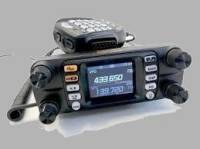|
Click The Radio Image On The Left To Return To Homepage Feel Free To Copy Any Information On The Webpages |
| |
|
Antenna Tuners Vs Couplers
Antenna tuners and couplers are not the same thing.
The question of 'tuner' and 'coupler' and the distinction between them is a point on which you will find quite a bit of confusion and contention. All for no reason. The words are often used interchangeably, so many people equate them in their minds. People who use the words to represent different things make the distinction based on what each thing does.
A TUNER is something which TUNES just after the output of your transceiver. It's purpose is to match the feedline to the transceiver. What it tunes is the system composed of the feedline and the antenna to provide a 50 Ohm connection (or whatever impedance is needed for the match) for the transceiver.
A COUPLER is put at the feed point of the antenna. It's purpose is to match the antenna to the 50 ohm feedline (or whatever other impedance is needed, but usually it's 50 ohms). A coupler keeps the SWR down along the whole feedline, while a tuner does not.
So which do you want?
A tuner built into your rig is there to protect the transceiver, not to give you the best signal. It's convenient, simple, and at most HF frequencies, losses will be fairly minimal on a practical level.
A coupler at the antenna feed point will maximize your energy flow into the antenna, giving you the best signal possible with that physical antenna. A coupler automates the tuning by selecting the best match at the feed point to maximize energy flow. This minimizes SWR across the whole of the feed line which also minimizes energy loss. Since the coupler is completely independent with its own internal intelligence, it operates completely without attention once it's properly installed.
The cost of both can be almost the same, in my opinion, I would always choose the "coupler" over a antenna "tuner" for the reasons pointed out above. A antenna coupler is a remote device that is installed at the antenna feedpoint, it doesn't sit on your desk inside the ham shack. Antenna couplers will require that you install the coupler outside of the ham shack.
The manuals that come with coupers are very thorough and will suggest various antennas and installtion techniques.
Whose antenna coupler shoud I purchase?
The top of the line are the SGC couplers, they are military spec and are used in aircraft, marine, and military applications, and YES, amateur radio applications. MFJ offers a line of remote antenna couplers, they're more than suitable for amateur radio application and will save you $100 - $200 and more depending the wattage handling capability of the coupler you choose to purchase.
Reliability:
I have owned both, my first antenna couplers were the SGC-230, SGC-231, & the SGC-237, they're all extremely reliable and I have never had a failure with any of them over the 20 years I they been in service.
MFJ provides several versions of their remote antenna couplers, the MFJ-926B 200 watt model, the MFJ-993BRT 300 watt model, & the MFJ-994BRT 600 watt model, and the MFJ-998RT 1500 watt model. The one I own is a MFJ-993BRT 300 watt model. My operating has been limited to barefoot operation with standard 100 watt transveivers.
I have never found the need to power my way on the frequencies with 1500 watts, splattering the bandwidth with 75 KHZ wide buck shot. I have worked the world with 100 watts and with attention paid to erecting effective coupled antennas with good filtering. All my HF antennas have been homebrew, including 160 meters. As with the SGC couplers, my MFJ-993BRT has performed admirably without any failures.
Read my section on the "The Forgotten Band" on how to get on 160 meters with a small but effective antenna utilizing a antenna coupler.
Bob Krueger, AB7CQ Web Administrator 146.920/146.320 PL 123.0 444.600 / 449.600 PL 100 Repeater IRLP Node: 7515 PL 114.8 ab7cqradio@ebidpal.com
You are here: Home-Tuners Vs Couplers Previous Topic: The Forgotten Band Next Topic: 6M & 10M FM
|
